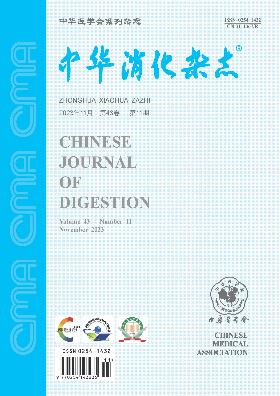Efficacy and safety of rifabutin and furazolidone included triple regimen and minocycline plus furazolidone included quadruple regimen in eradicating refractory Helicobacter pylori infection
引用次数: 0
Abstract
Objective To observe the efficacy and safety of rifabutin and furazolidone included triple regimen and minocycline plus furazolidone included quadruple regimen in eradicating refractory H. pylori infection. Methods A total of 146 patients who failed (≥two times) to treat H. pylori with standard anti-H.pylori therapy were selected and divided into esomeprazole, rifabutin and furazolidone treatment group (ERF group, n=74) and esomeprazole, minocycline, furazolidone and bismuth potassium citrate group (EMFB group, n=72). The duration of treatment were both 10 days. Liver and renal functions were examined within three days after therapy. 13C or 14C-urease breath test was performed one month after the medication withdrawal. The patients were followed up once every two weeks during the treatment period. The medication and adverse reactions were recorded in detail. The compliance and rates of adverse events in two groups were compared and analyzed. The eradication rates of the two groups and subgroups were compared by intention-to-treat (ITT) and per-protocol (PP) analyses. The cost-effectiveness of the two groups was evaluated with cost effectiveness analysis (CEA). The cost/effectiveness (C/E) ratio was calculated by PP. Chi-square test and t test were used for statistical analysis. Results There was no significant difference in complicance between ERF group and EMFB group (90.5% vs. 90.3%, P>0.05). There was no significant difference in H. pylori eradication rate between ERF group and EMFB group analyzed by ITT (82.4% vs. 84.7%, P>0.05). Analyzed by PP, there were no significant differences in H. pylori eradication rate between ERF group and EMFB group (91.0% vs. 93.8%), between male subgroup and female subgroup of ERF group (87.9% vs. 94.1%), between subgroup with age less than 60 years and subgroup with age over 60 years of ERF group (89.7% vs. 92.9%), between male subgroup and female subgroup of EMFB group (89.7% vs. 97.2%) and between subgroup with age less than 60 years and subgroup with age over 60 years of EMFB group (93.6% vs. 94.4%) (all P>0.05). There were no statistically significant differences in the rate of adverse events between ERF group and EMFB group (20.3% vs. 22.2%), between male subgroup and female subgroup of ERF group (25.0% vs. 15.8%), between subgroup with age less than 60 years and subgroup with age over 60 years of ERF group (26.2% vs. 12.5%), between male subgroup and female subgroup of EMFB group (19.4% vs. 24.4%) and between subgroup with age less than 60 years and subgroup with age over 60 years of EMFB group (24.5% vs. 15.8%) (all P>0.05). Fixed daily cost, total cost and C/E of ERF group was RMB 59.0 yuan, RMB 590.5 yuan and 648.9, respectively; and the eradication rate was 91.0%(61/67). Fixed daily cost, total cost and C/E of EMFB group was RMB 32.9 yuan, RMB 329.1 yuan and 350.9, respectively; and the eradication rate was 93.8%(61/65). Conclusions Rifabutin and furazolidone included triple regimen and minocycline plus furazolidone included quadruple regimen both have good efficacy, safety and compliance in the eradication of refractory H. pylori infection, and the latter is better. Key words: Rifabutin; Furazolidone; Minocycline; Refractory H. pylori infection; Efficacy利福布汀联合呋喃唑酮三联方案和米诺环素联合呋喃唑酮四联方案根除难治性幽门螺杆菌感染的疗效和安全性
目的观察利福布汀联合呋喃唑酮三联用药和米诺环素联合呋喃唑酮四联用药根除难治性幽门螺杆菌感染的疗效和安全性。方法采用标准抗幽门螺杆菌治疗幽门螺杆菌失败(≥2次)患者146例。选择幽门螺杆菌治疗方法,分为埃索美拉唑、利福布汀、呋喃唑酮治疗组(ERF组,n=74)和埃索美拉唑、米诺环素、呋喃唑酮、柠檬酸铋钾治疗组(EMFB组,n=72)。治疗时间均为10天。治疗后3天内检查肝肾功能。停药1个月后进行13C或14c脲酶呼气试验。治疗期间每两周随访1次。详细记录用药情况及不良反应。比较分析两组患者的治疗依从性和不良事件发生率。通过意向治疗(ITT)和每个方案(PP)分析比较两组和亚组的根除率。采用成本-效果分析(cost-effectiveness analysis, CEA)评价两组患者的成本-效果。成本/效果(C/E)比值采用PP计算,采用卡方检验和t检验进行统计分析。结果ERF组与EMFB组患者的依从性比较差异无统计学意义(90.5% vs 90.3%, P>0.05)。ITT分析ERF组与EMFB组幽门螺杆菌根除率差异无统计学意义(82.4% vs 84.7%, P>0.05)。经PP分析,ERF组与EMFB组幽门螺杆菌根除率(91.0%比93.8%)、ERF组男性亚组与女性亚组(87.9%比94.1%)、ERF组年龄小于60岁亚组与年龄大于60岁亚组(89.7%比92.9%)无显著差异。EMFB组男性亚组与女性亚组之间(89.7% vs 97.2%)、60岁以下亚组与60岁以上亚组之间(93.6% vs 94.4%)(均P>0.05)。ERF组与EMFB组不良事件发生率(20.3% vs. 22.2%)、ERF组男性亚组与女性亚组不良事件发生率(25.0% vs. 15.8%)、ERF组60岁以下亚组与60岁以上亚组不良事件发生率(26.2% vs. 12.5%)差异均无统计学意义。EMFB组男性亚组与女性亚组间差异(19.4%比24.4%),60岁以下亚组与60岁以上亚组间差异(24.5%比15.8%)(均P>0.05)。ERF组固定日成本59.0元,总成本590.5元,C/E为648.9元;根除率为91.0%(61/67)。EMFB组固定日成本为32.9元,总成本为329.1元,成本成本比为350.9元;根除率为93.8%(61/65)。结论利福布汀联合呋喃唑酮三联用药方案和米诺环素联合呋喃唑酮四联用药方案对根除难治性幽门螺杆菌感染均具有良好的疗效、安全性和依从性,且后者较好。关键词:瑞法布汀;呋喃唑酮;二甲胺四环素;难治性幽门螺杆菌感染;功效
本文章由计算机程序翻译,如有差异,请以英文原文为准。
求助全文
约1分钟内获得全文
求助全文

 求助内容:
求助内容: 应助结果提醒方式:
应助结果提醒方式:


